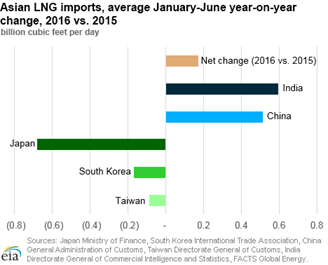EIA: Asian LNG imports increase in 2016, led by India and China

Graphic courtesy of the US Energy Information Administration.
According to the EIA, Asian countries may see increasing volumes of spot shipments from the US, as more US liquefaction capacity comes online in the next three years, and transit through the expanded Panama Canal reduces shipping costs and travel time between Atlantic and Pacific basins.
Five Asian countries (Japan, South Korea, China, India, and Taiwan) accounted for 68% of global LNG imports in 2015. In the first six months of 2016, in total, these five countries only increased their LNG import volumes by 1% (0.2 Bcfd), compared to the same period last year. However, higher imports in China and India more than offset declines in LNG consumption in the established markets of Japan and South Korea.
China and India, the world’s third and fourth largest LNG importers, together accounting for 14% of global LNG trade in 2015, increased their LNG imports in the first six months of this year, as compared to the same period last year, by 20% and 41%, respectively. In China, the combination of the ramping-up of several LNG supply contracts, including new projects in Australia, and historically low spot LNG prices contributed to higher LNG imports. In India, new government subsidies offered by the Power Supply Development Fund to run natural gas-fired power plants led to higher LNG imports.
In Japan and South Korea—the world’s two largest LNG importers, together accounting for almost half of global LNG trade in 2015—LNG imports have been declining for the past two years. In Japan, average January-June LNG imports in 2016 were 6% lower than in the same period last year and 8% lower than in 2014. Since 2015, Japan has been experiencing lower LNG consumption in the power generation sector. This is primarily a result of lost market share to lower-priced coal generation and increased generation from renewable sources, and the return of two nuclear reactors. Similarly, South Korea’s decrease in LNG imports was driven by higher generation from nuclear and coal units, which is expected to continue in the future. In Taiwan, lower LNG imports this year were driven by the return to service of several coal-fired power plants.

- Gasum powers Equinor's platform supply vessel with bio-LNG
- ADNOC deploys pioneering AI-enabled process optimization technology
- Mexico Pacific announces long-term LNG SPA with POSCO International
- ONEOK to acquire Medallion and controlling interest in EnLink for $5.9 B
- Golar LNG signs EPC deal for $2.2-B MK II FLNG conversion project



Comments